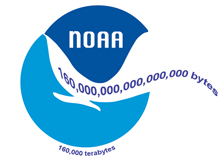NOAA Has CLASS!

NOAA’s data holdings are expected to grow to 160,000 terabytes by 2020. The prefix “tera” originates from the Greek and means “monster.” Click image for larger view.
Current estimates from NOAA's data management system predict that the amount of archived data will grow to more than 160,000 terabytes by 2020. There are 1012 bytes in a terabyte, which translates into a lot of data!
NOAA expects a doubling of data every year for the next several years from NOAA's new environmental observing systems. Satellite operators, including NOAA, are developing more powerful instruments for remote sensing of the atmosphere, oceans, land, and space. These systems are expected to collect and transmit data at the rate of about 20 million bits per second. The current rate of data collection is one to two million bits per second.

Comprehensive Large Array-data Stewardship System (CLASS) is an online data management system that gives users faster, easier access to America’s environmental data.
NOAA has a "classy" way of handling environmental data called the Comprehensive Large Array-data Stewardship System (CLASS). CLASS is an online data management system that gives users faster, easier access to America's environmental data. CLASS is a key component of NOAA's integrated global observation and data management system.
CLASS is NOAA's premier online facility for the distribution of data from the following satellite and observing systems:
- NOAA Polar-orbiting Operational Environmental Satellite (POES)
- NOAA's Geostationary Operational Environmental Satellite (GOES)
- NASA's Earth Observing System (EOS)
- U.S. Department of Defense Meteorological Satellite Program (DMSP)
CLASS is evolving to support additional satellite data streams, environmental sensors, and data from buoys, plus geophysical and solar environmental data. CLASS is in its third year of a major 10-year growth program, adding new data sets and functionality to support a broader user base.

Over the next 15 years, data that are archived will grow to more than 160,000 terabytes. Click image for larger view.
The development of CLASS is expected to be a long-term, evolving process, as current and new campaigns are incorporated into the CLASS architecture. To house CLASS, two separate physical sites with full data processing capabilities are required. If one site is not functional, this avoids any potential loss of data. This meets security requirements for disaster backup and data restoration. Lastly, CLASS is moving toward becoming the main distribution source of observational environmental data generated by NOAA.
Related Web Sites
NOAA's Comprehensive Large Array-data Stewardship System (CLASS)
